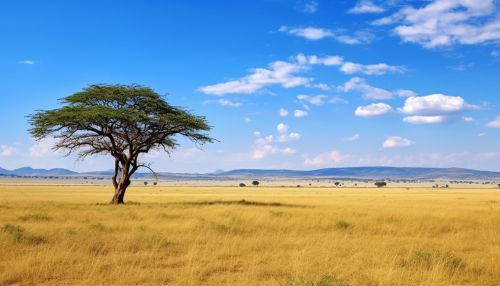Serengeti National Park
Overview
The Serengeti National Park is a large national park located in northern Tanzania. It spans approximately 14,763 square kilometers and is renowned for its annual migration of over 1.5 million white-bearded (or brindled) wildebeest and 250,000 zebra. The park is also home to the largest and most diverse concentration of wild animals in the world.


Geography
The Serengeti National Park is located in the Serengeti ecosystem in the Mara and Simiyu regions. The park covers a vast area of grassland plains, savanna, riverine forest, and woodlands. The park lies in the northwestern part of Tanzania and is contiguous with the Maasai Mara national reserve in Kenya.
The park is divided into three regions: Serengeti plains, Western corridor, and Northern Serengeti. The Serengeti plains are the most iconic and contain the largest concentration of wildlife. The Western corridor is covered by black clay soil and hosts the Grumeti River, which is known for its population of Nile crocodiles. The Northern Serengeti is less visited and is dominated by open woodlands and hills, ranging from Seronera in the south to the Mara River in the border with Kenya.
Biodiversity
The Serengeti National Park is home to a large and diverse range of wildlife, including over 70 large mammal species and around 500 bird species. This includes the largest population of lions in Africa, with an estimated 3,000 lions in 300 prides. Other predators include leopard, cheetah, hyena, and African wild dogs.
The park is most famous for its annual migration, when an estimated 1.5 million wildebeest and 250,000 zebras travel from the northern hills toward the southern plains for the short rains in October and November, and then west and north after the long rains in April, May, and June. This migration is one of the most impressive natural events and involves crossing rivers infested with crocodiles.


Conservation
The Serengeti National Park has been a protected area since the 1940s, and in 1981, it was designated as a UNESCO World Heritage Site. The park's ecosystem is one of the oldest on earth, where the essential features of climate, vegetation, and fauna have barely changed in the past million years.
However, the park faces several conservation challenges, including poaching, fire, and interaction with human activities. The Tanzanian government and several international organizations are working to protect the park and its wildlife.
Tourism
Tourism is a significant part of the park's economy, with thousands of visitors each year. The park offers a variety of activities, including game drives, hot air balloon rides, picnicking, camping, and walking safaris. The best time to visit the park is during the wildebeest migration, usually from late June to August.
